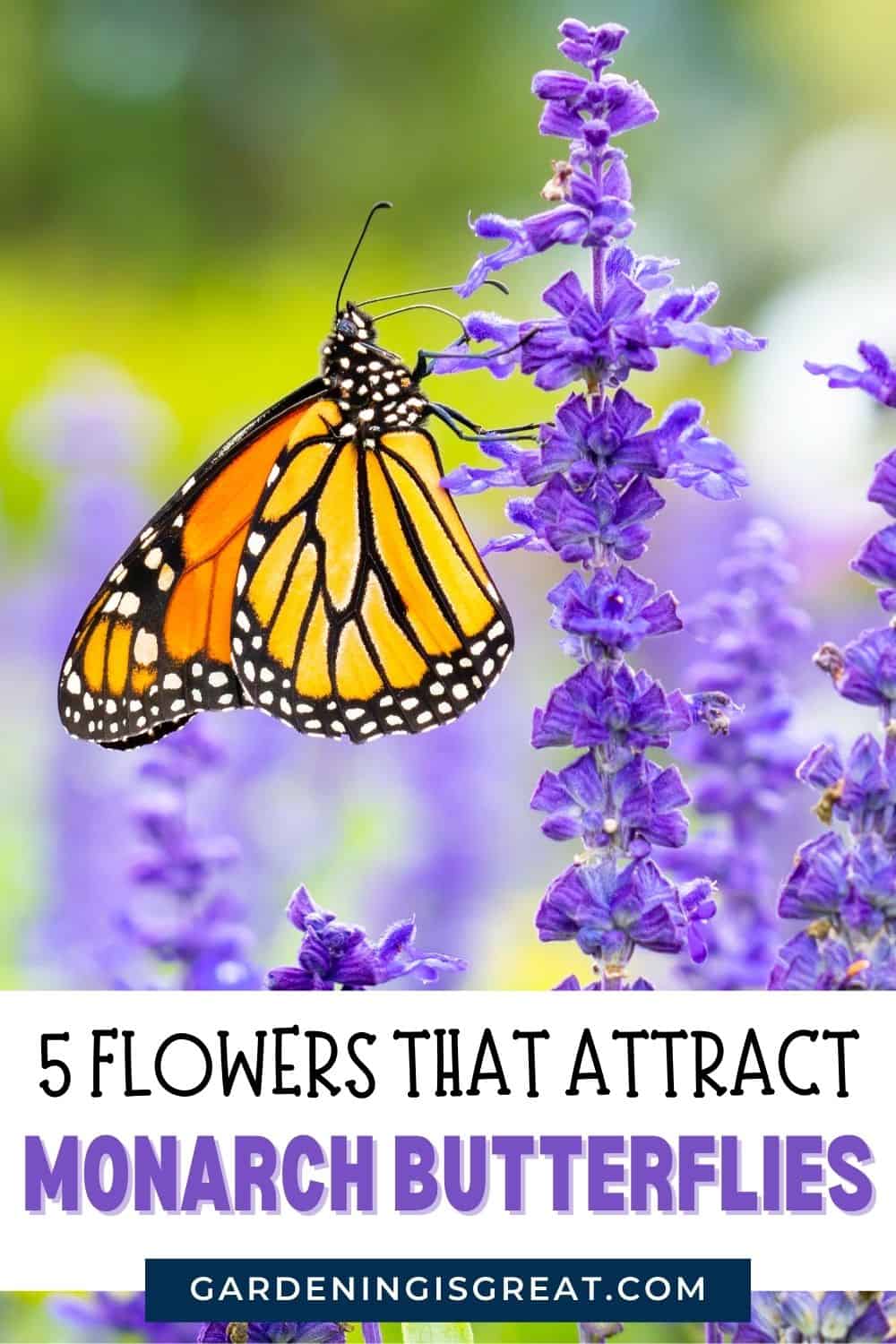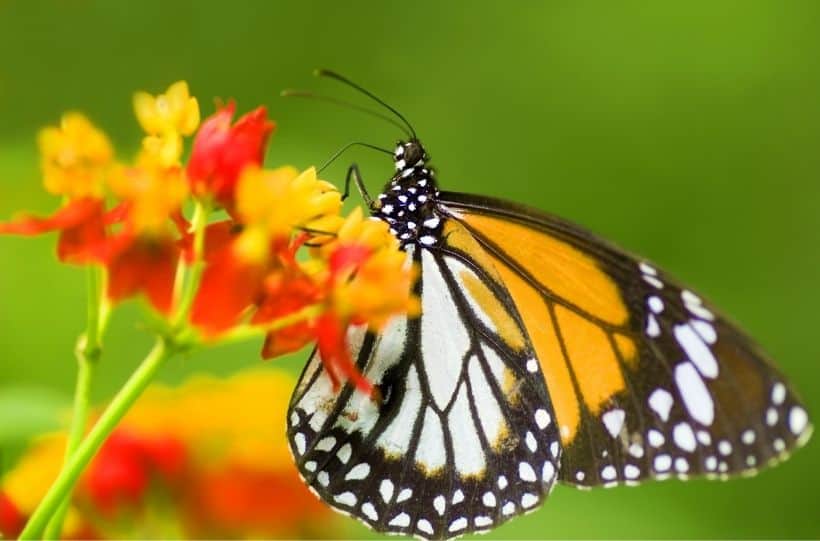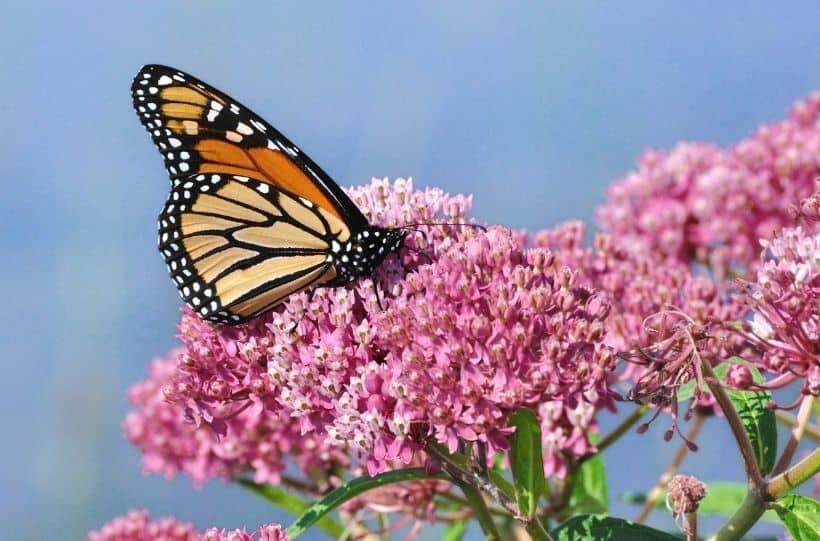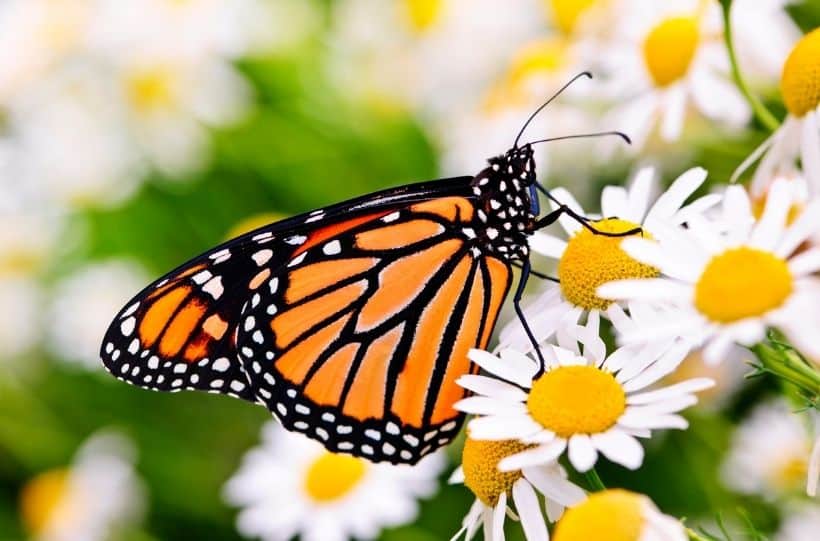5 Flowers That Attract Monarch Butterflies
Monarch butterflies are a species native to North America that has deep orange wings with black borders and veins and white spots on the edges. During their migration season, they can be found as far north as Canada and as south as Mexico.
Unfortunately, monarch butterflies are an endangered species due to:
- Habitat loss
- Loss of food
- Pesticides
- Herbicides
- Climate change.
Being such an iconic butterfly species in America that participates in a unique and incredible migration, people are trying to find ways to help protect and support them.

If you live in America, you too can help by planting flowers that attract monarch butterflies to your garden.
Not only will this encourage these incredible butterflies to visit your garden, but you will directly help to provide monarch butterflies with
- essential shelter,
- Nectar rich food,
- and a safe place to lay their eggs.
Take a look at these flowers that attract monarch butterflies in this list below.
Top Tips To Attract Monarch Butterflies To Your Garden
Before taking a look at the different flowers you can plant, here are some top tips to ensure you maximize the space available in your garden to attract monarch butterflies:
Milkweed
Milkweed is an essential plant to add to your garden if you are looking to attract monarch butterflies. Monarch butterflies rely on this plant to survive. They use it not only to feed but to lay their eggs. Once the caterpillars hatch, they solely eat milkweed until turning into butterflies.
With over 100 species of milkweed native to North America, it’s ideal to plant at least 2 in your garden to provide enough food for caterpillars to eat and space for adult monarchs to lay their eggs.
Native Plants
Even though exotic species may seem more exciting to add to your garden, oftentimes, these plants do not flower at the right time or provide enough food for monarch butterflies. The flowers may be more closed, making it difficult for monarchs to access the nectar they need.
Whereas native plants are used to the climate and soil condition. They flower seasonally, so when choosing specific flowers, they will provide food when monarch butterflies are most active.
Nectar-rich Plants
Nectar-rich plants are plants with a higher amount of nectar compared to others. Selecting nectar-rich plants will help ensure there is a larger supply of food for monarch butterflies. These flowers will also help support other local pollinators too, such as bees and hummingbirds.
Colour
Though most brightly-colored flowers will attract pollinators into your garden, monarch butterflies are attracted more to orange, pink, red, yellow, and purple flowers.

Focus on planting large groups of these colors together to attract monarch butterflies.
Flower Type
The type of flower can also make a difference in whether monarch butterflies and other pollinators visit your garden. Choosing open, flat flowers or small clustered flowers that both have easy access to nectar will attract more monarch butterflies than those that are closed or difficult to access.
Chemical-free
Finally, and perhaps most importantly, ensure that your garden is completely free from chemicals. If using fertilizers or managing pests, use natural and organic methods avoiding chemicals at all times.
Chemicals have been detrimental to monarch butterfly populations, causing huge numbers of deaths. You can still maintain your garden without the need for harmful chemicals, all while helping to protect this endangered species.
5 Flowers That Attract Monarch Butterflies
Now you know what type of flowers to look for and ensure your garden is pollinator-friendly, here are some flowers that are ideal to plant in your garden to attract monarch butterflies.
Swamp Milkweed
Swamp milkweed is a popular flower for monarch butterflies. It grows in clumps of delicate, open flowers in pink, purple, red, and white.

They can grow up to 5 feet tall and are a critical plant for monarch butterflies for adults to lay their eggs and food for both adults and caterpillars.
Swamp milkweed is a perennial plant that will regrow year after year. It is best planted in full sunlight and well-drained soil. The flowers are in bloom between the mid to late summer months.
Though milkweed is ideal to plant for monarch butterflies, do be careful if you have pets. Milkweed is toxic to animals and people.
Showy Milkweed
Showy milkweed provides small, star-shaped flowers that are grouped in light shades of pink or purple.
A smaller milkweed variety than swamp milkweed, it can grow up to 3 feet tall and prefers full sunlight and well-drained soil.
The flowers bloom between May and June, making it a great flower to plant alongside swamp milkweed to provide food throughout the whole summer.
Butterfly Bush
Also known as a Buddleia, butterfly bushes are excellent for all pollinators, not just monarch butterflies.
This large shrub offers long cones of tiny flowers grouped that are open and nectar-rich.
They can grow up to 12 feet tall and require full sunlight and well-drained soil. Butterfly bushes have a long blooming period between June and September, with flowers in shades of white, yellow, blue, purple, and pink.
Asters
Available in blue, pink, red, purple, and white, these daisy-like flowers have long, open petals allowing easy access to their nectar.
Another perennial plant that helps to provide pollinators with food year after year, each flower can grow up to 6 feet tall.
Asters prefer to be planted in an area of full sunlight with well-drained soil. Their flowers bloom between the late summer months and autumn, offering food for pollinators later in the season.
Lilac
Lilac shrubs bloom earlier in the summer, between May and July. Their tubular flowers are available in white, pink, or purple, ideal for monarch butterflies.
They need to be grown in full sunlight with well-drained soil. Each plant can grow to 12 feet tall and needs pruning each year after the growing season to aid a successful bloom the following year.

By planting these 5 flowers in your garden, you will help to provide a range of food sources and shelter for monarch butterflies. The bright, bold colors in pinks and purples will not only help attract them into your garden but attract other pollinators too.
These open flowers offer easy access to nectar and also cover a long flowering season between them from May to September.
If you are wanting to encourage more pollinators to visit your garden, take a look at these helpful posts here:

